| Pages:
1
2
3
4
5
6
..
8 |
Pathos
Harmless

Posts: 14
Registered: 16-8-2012
Location: Top shelf, over to the Left
Member Is Offline
Mood: Quixotic
|
|
Might as well post these while I'm at it...
1. Smokey Quartz
2. Rose Quartz
3. White Tourmaline with what looks like black tourmaline - but its actually the smallest "Watermelon tourmaline" I've ever seen! lol
4&5. Name that rock? Heh...I found these digging through my collection and can't remember for the life of me what they're called. Eventually I can
ask the friend I got them from and he'll remember, but figured I'd post here first. Any guesses?
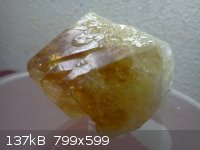 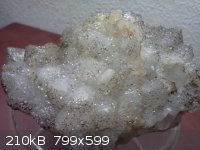 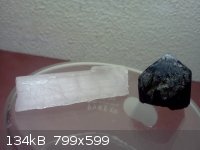 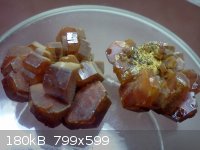 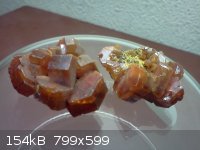
"Hoc natura est insitum, ut quem timueris, hunc semper oderis"
~
"It is an innate thing for people to always hate what they've learned to fear"
-Roman Proverb-
|
|
|
bfesser
Resident Wikipedian
    
Posts: 2114
Registered: 29-1-2008
Member Is Offline
Mood: No Mood
|
|
Pathos, I have three questions for you regarding your photos. First—and I'm being serious, here—do you have any
color-blindness? If not, and second; what type of camera are you using to take these photos? Finally, did you collect these specimens yourself or
did you purchase them (implied: do you know the localities)?
Perhaps it's just the photos, but I don't see as much as a tinge of blue-green in your 'aquamarine' specimens. If they were my own, I would label
them as <a href="https://en.wikipedia.org/wiki/Beryl" target="_blank">beryl</a> <img src="../scipics/_wiki.png" /> with muscovite.
They're absolutely beautiful, nonetheless—I particularly like the terminated specimen in the 5th–7th photos. The phantoms in the
fluorite are likewise beautiful. I love your specimens.
In your last post, the smokey quartz looks a bit like citrine. But these distinctions are more gemological than mineralogical, I think. As with the
beryl, I'm not seeing the expected color in your photo of 'rose quartz.' How did you come to the identities of the specimens in the third
photo—to me, they don't seem to match your description.
As for the specimens for which you've forgotten the name, they're <a href="https://en.wikipedia.org/wiki/Vanadinite"
target="_blank">vanadinite</a> <img src="../scipics/_wiki.png" />—and I'm 100% certain of it. They look to be quite
sun-damaged, however. I'd recommend keep them in a dark dry place when you're not enjoying viewing them. I posted a <a
href="viewthread.php?tid=14644&page=17#pid247603">bad photo of a vanadinite</a> specimen in my collection, a couple years ago.
[Edited on 3.2.14 by bfesser]
|
|
|
blargish
Hazard to Others
  
Posts: 166
Registered: 25-9-2013
Location: Canada
Member Is Offline
Mood: Mode Push
|
|
On the topic of beryl, here is an emerald vein in a biotite schist.
Also, I have this bought specimen that is labeled Magnetite /w Matrix (which seems to be a schist or phyllite). However, the octahedral crystals show
no response to any magnet and do not deflect a compass needle. I have always thought that magnetite was magnetic... Any thoughts?
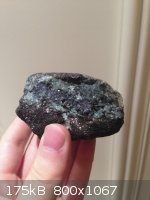 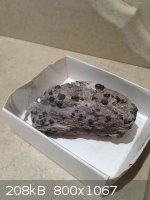
BLaRgISH
|
|
|
Morgan
International Hazard
    
Posts: 1694
Registered: 28-12-2010
Member Is Offline
Mood: No Mood
|
|
Some common rocks and ordinary unloved rocks with different patterns in them ... I like the one on the end of the top row for the tiny root-like
features. You can see them better if you enlarge the photo.
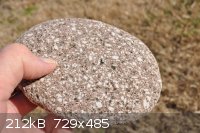 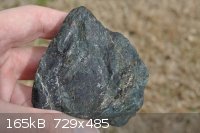 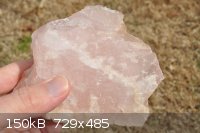 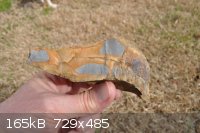 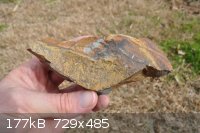 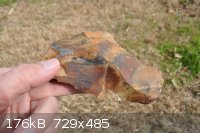 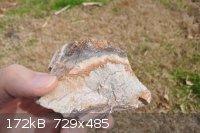 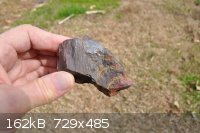 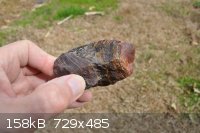 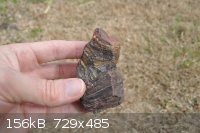
[Edited on 3-2-2014 by Morgan]
|
|
|
Morgan
International Hazard
    
Posts: 1694
Registered: 28-12-2010
Member Is Offline
Mood: No Mood
|
|
Bear with me, I've more.
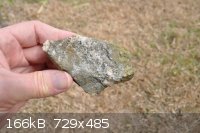 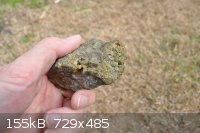 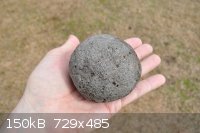 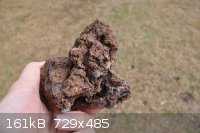 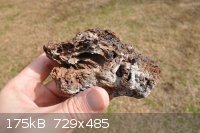 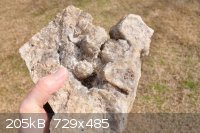 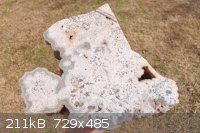 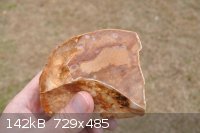 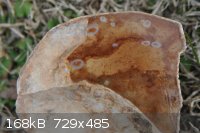
|
|
|
Morgan
International Hazard
    
Posts: 1694
Registered: 28-12-2010
Member Is Offline
Mood: No Mood
|
|
Blessedly the last.
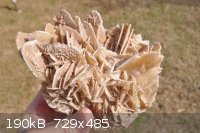 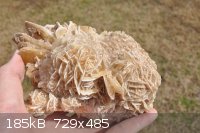 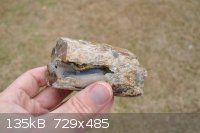 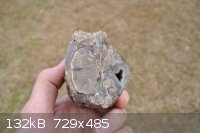 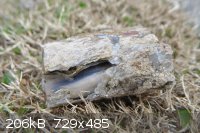 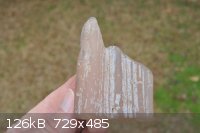 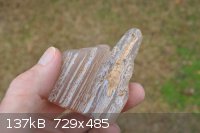 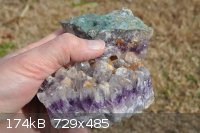
|
|
|
Morgan
International Hazard
    
Posts: 1694
Registered: 28-12-2010
Member Is Offline
Mood: No Mood
|
|
I was looking at your clear fluorite crystals Pathos and it reminded me of mine that I have in a box somewhere but they are purple. And I was
wondering if it was iron or manganese or what that makes them purple? In the article below, very large cubic crystals occur.
Are there any minerals that are a mix of calcium fluoride and other salts? I remember an old book on growing crystals where you could distort the
crystals by adding other salts.
"Fluorite comes in a wide range of colors and has subsequently been dubbed "the most colorful mineral in the world". The most common colors are
purple, blue, green, yellow, or colorless. Less common are pink, red, white, brown, black, and nearly every shade in between. Color zoning or banding
is commonly present. The color of the fluorite is determined by factors including impurities, exposure to radiation, and the size of the color
centers."
http://en.wikipedia.org/wiki/Fluorite
|
|
|
bfesser
Resident Wikipedian
    
Posts: 2114
Registered: 29-1-2008
Member Is Offline
Mood: No Mood
|
|
Coloration in minerals isn't always caused by the presence of transition metal ions. Colors can also arise from the optical effects (diffraction) of
physical structures within the specimen (pseudochromatic) and a certain type of crystallographic defect called an <a
href="https://en.wikipedia.org/wiki/F-Center" target="_blank">F-Center</a> <img src="../scipics/_wiki.png" />, which are created by
naturally occurring ionizing radiation—as hinted at in your quote. Of course, man has taken advantage of this phenomena to produce
artificially colored gems, which are sometimes misleadingly sold as natural specimens.
See also:
<a href="http://www.minsocam.org/msa/collectors_corner/arc/color.htm" target="_blank">The Origins of Color in Minerals</a> <img
src="../scipics/_ext.png" /> (American Mineralogist)
<a href="http://minerals.gps.caltech.edu/color_causes/" target="_blank">The Colors of Minerals</a> <img src="../scipics/_ext.png" />
(Caltech)
<a href="http://www.minsocam.org/msa/collectors_corner/arc/colorradiation.htm" target="_blank">The Coloring and Thermophosphorescence Produced
in Transparent Minerals and Gems by Radium Radiation</a> <img src="../scipics/_ext.png" /> (American Mineralogist)
<a href="http://www.enmu.edu/services/museums/miles-mineral/colors.shtml" target="_blank">Colors in Minerals</a> <img
src="../scipics/_ext.png" /> (Eastern New Mexico University)
On a related note; there has been a huge influx artificial 'mineral specimens' on the market which are originating from China and
Poland—surely other countries, as well—at the moment, so just be mindful of this if you're purchasing specimens off eBay and the
like. Some of the minerals are artificially colored by exposure to ionizing radiation, heat treatment, or similar means. Some of the specimens
(CuSO<sub>4</sub> and Bi, in particular) are just lab grown fakes. And some specimens are even glued together from unrelated minerals.
Some of the sellers advertise this plainly (e.g. <a href="http://www.ebay.com/itm/131104787298" target="_blank">"Chalcanthite - Lab Grown in
Poland"</a> <img src="../scipics/_ext.png" /> , others hide the truth in
fine print; some are ambiguous (e.g. <a href="http://www.ebay.com/itm/331120436704" target="_blank">"DINO: RAINBOW BISMUTH Crystal Mineral
Specimen - 33 gr. Germany"</a> <img src="../scipics/_wiki.png" /> , others hide the truth in
fine print; some are ambiguous (e.g. <a href="http://www.ebay.com/itm/331120436704" target="_blank">"DINO: RAINBOW BISMUTH Crystal Mineral
Specimen - 33 gr. Germany"</a> <img src="../scipics/_wiki.png" /> , and
a few just lie outright. , and
a few just lie outright.
See also:
<a href="http://www.the-vug.com/vug/vugfakes.html" target="_blank">Fake Crystals, Minerals, Gemstones, Lapidary and Fossils Guide</a>
<img src="../scipics/_ext.png" /> (The-Vug.com)
<a href="http://www.fakeminerals.com/" target="_blank">FakeMinerals.com/</a> <img src="../scipics/_ext.png" />
[note: I recently watched a recording of an interesting lecture on this topic (F-centers), but it was on a DVD that I don't own. I'll try to find a
copy to share. I also had a couple papers and a book to share, but I'll likewise have to retrieve them. I will be editing this post, as usual; so
please don't quote it.]
[Edited on 8.2.14 by bfesser]
|
|
|
Morgan
International Hazard
    
Posts: 1694
Registered: 28-12-2010
Member Is Offline
Mood: No Mood
|
|
I was looking in a few boxes for my purple fluorite crystals and came across these rocks in boxes. The first one didn't photograph well, it's
exceedingly glittery but not for the camera. It's a magic rock, completely jet black in indoor light.
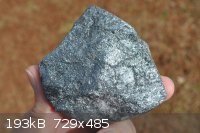 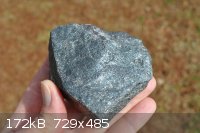 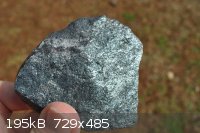 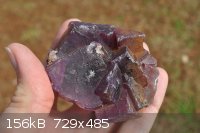 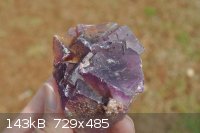 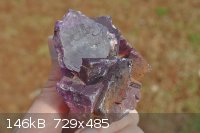 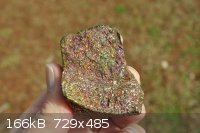 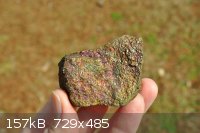 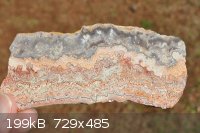 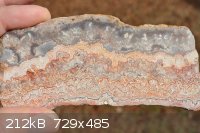
|
|
|
Morgan
International Hazard
    
Posts: 1694
Registered: 28-12-2010
Member Is Offline
Mood: No Mood
|
|
More box rocks.
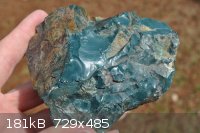 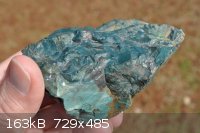 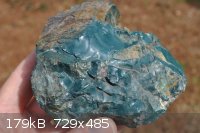 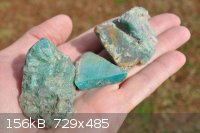 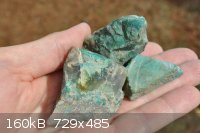 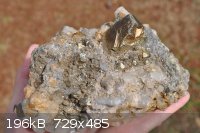 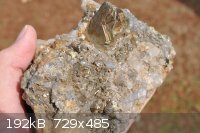 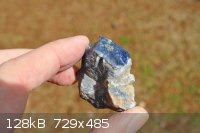 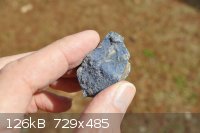
|
|
|
Morgan
International Hazard
    
Posts: 1694
Registered: 28-12-2010
Member Is Offline
Mood: No Mood
|
|
The last of these.
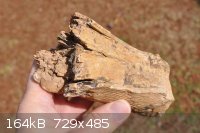 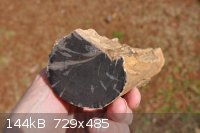 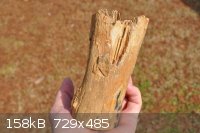 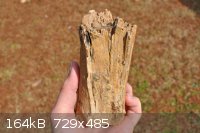 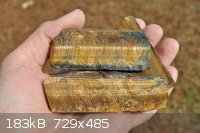 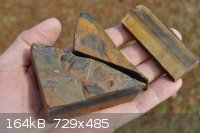 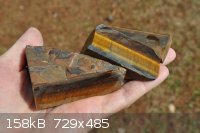
|
|
|
blargish
Hazard to Others
  
Posts: 166
Registered: 25-9-2013
Location: Canada
Member Is Offline
Mood: Mode Push
|
|
Some of those look really cool! The golden-rainbowish one in your first set of pictures looks like bornite or chalcopyrite (I'm not really sure how I
can tell them apart in their massive forms).
I have no clue what the first rock is in the second group of photos you posted. The group of lighter ones that follow seem to be turquoise, but I'm
not so sure. My guess for the final blue rock in your second group of images is sodalite.
Love the pictures!
BLaRgISH
|
|
|
Morgan
International Hazard
    
Posts: 1694
Registered: 28-12-2010
Member Is Offline
Mood: No Mood
|
|
I noticed the fake mineral link had some acanthite ore that was said to have been heated to form the "silver wires." It's funny how they look like
some frost flowers, plants chilled to form ice ribbons.
http://www.the-vug.com/vug/vugfakes.html
http://en.wikipedia.org/wiki/Frost_flower
http://my.ilstu.edu/~jrcarter/ice/
|
|
|
bfesser
Resident Wikipedian
    
Posts: 2114
Registered: 29-1-2008
Member Is Offline
Mood: No Mood
|
|
I'm going to repeat this; you generally can't identify a rock or mineral from photographs alone. That being said, here are my suggestions: Quote: Originally posted by blargish  | | Also, I have this bought specimen that is labeled Magnetite /w Matrix (which seems to be a schist or phyllite). However, the octahedral crystals show
no response to any magnet and do not deflect a compass needle. I have always thought that magnetite was magnetic... Any thoughts?
|
<strong>blargish</strong>, it could be a hematite <a
href="http://en.wikipedia.org/wiki/Pseudomorph" target="_blank">pseudomorph</a> <img src="../scipics/_wiki.png" /> after <a
href="http://en.wikipedia.org/wiki/Magnetite" target="_blank">magnetite</a> <img src="../scipics/_wiki.png" />; a red streak would
confirm this.
<strong>Morgan</strong>:
From <a href="viewthread.php?tid=28664&goto=search&pid=317757">this post</a>, 026.JPG is <a
href="http://en.wikipedia.org/wiki/Quartz#Rose_quartz" target="_blank">rose quartz</a> <img src="../scipics/_wiki.png" />. 047.JPG,
049.JPG, and 051.JPG look to be shale with various iron staining and <a href="http://en.wikipedia.org/wiki/Dendrite_(crystal)"
target="_blank">dendritic manganese</a> <img src="../scipics/_wiki.png" /> (clearly visible in the second photo). Apply a drop of 3 %
H<sub>2</sub>O<sub>2</sub>(aq) to the dendrites to watch the effervescence as the Mn/Fe oxides catalytically decompose the
peroxide, producing oxygen.
From <a href="viewthread.php?tid=28664&goto=search&pid=317759">this post</a>, 098.JPG & 100.JPG look like <a
href="http://www.blm.gov/wy/st/en/resources/public_room/gis/metadata/clinker-wy.html" target="_blank">clinker</a> <img
src="../scipics/_ext.png" /> (metamorphic produced by naturally burning coal beds) or maybe <a href="http://en.wikipedia.org/wiki/Scoria"
target="_blank">scoria</a> <img src="../scipics/_wiki.png" /> (volcanic). Many would erroneously guess <a
href="http://en.wikipedia.org/wiki/Pumice" target="_blank">pumice</a> <img src="../scipics/_wiki.png" /> (volcanic).
<table><tr><td><a href="http://www.flickr.com/photos/35937732@N02/12021779824/" title="Clinker by bfesser, on Flickr"
target="_blank"><img src="http://farm8.staticflickr.com/7428/12021779824_cf3b7df3f7_m.jpg" width="240" height="180"
alt="Clinker"></a></td></tr><tr><td align="center">Clinker, <a
href="http://en.wikipedia.org/wiki/Powder_River_Basin" target="_blank">Powder River Basin</a> <img src="../scipics/_wiki.png" />,
WY</td></tr></table>
From <a href="viewthread.php?tid=28664&goto=search&pid=317761">this post</a>, 112.JPG & 117.JPG are a crystal formation called
(colloquially) a <a href="http://en.wikipedia.org/wiki/Desert_rose_(crystal)" target="_blank">'desert rose'</a> <img
src="../scipics/_wiki.png" />. It could be <a href="http://en.wikipedia.org/wiki/Gypsum" target="_blank">gypsum</a> <img
src="../scipics/_wiki.png" /> or <a href="http://en.wikipedia.org/wiki/Baryte" target="_blank">baryte</a> <img
src="../scipics/_wiki.png" />.
From <a href="viewthread.php?tid=28664&goto=search&pid318286">this post</a>, 007.JPG, 008.JPG, and 010.JPG are very obviously
fluorite. You should wrap the specimen in newspaper to protect it from further damage in the boxes. 013.JPG and 014.JPG are <a
href="http://en.wikipedia.org/wiki/Chalcopyrite" target="_blank">chalcopyrite</a> <img src="../scipics/_wiki.png" />, possibly <a
href="http://en.wikipedia.org/wiki/Bornite">bornite</a> <img src="../scipics/_wiki.png" />, as <strong>blargish</strong>
suggested.
Finally, from <a href="viewthread.php?tid=28664&goto=search&pid=318287">this post</a>, 024.JPG, 025.JPG, & 027.JPG look like
<a href="http://en.wikipedia.org/wiki/Chrysocolla" target="_blank">chrysocolla</a> <img src="../scipics/_wiki.png" />, which is
often mistaken for <a href="http://en.wikipedia.org/wiki/Turquoise" target="_blank">turquoise</a> <img src="../scipics/_wiki.png"
/>. 028.JPG & 031.JPG could be turquoise. 033.JPG and 037.JPG could be <a href="http://en.wikipedia.org/wiki/Pyrite"
target="_blank">pyrite</a> <img src="../scipics/_wiki.png" /> with a bit of <a href="http://en.wikipedia.org/wiki/Limonite"
target="_blank">limonite</a> <img src="../scipics/_wiki.png" /> on the surface, and quartz. 049.JPG and 050.jpg; <a
href="http://en.wikipedia.org/wiki/Azurite" target="_blank">azurite</a> <img src="../scipics/_wiki.png" />, perhaps?
[Edited on 9.2.14 by bfesser]
|
|
|
Morgan
International Hazard
    
Posts: 1694
Registered: 28-12-2010
Member Is Offline
Mood: No Mood
|
|
Thanks for the identifications bfesser. The dendritic manganese in Wiki looks like a piece of artwork. I like that effect.
The rock that looks like chrysocolla is such an odd color to me. And this angle shows another shade on one corner. The rock reminds me of clay that
became metamorphic.
http://www.sciencemadness.org/talk/files.php?pid=318287&...
I've a couple of larger fluorite crystal clusters somewhere, with full cubes all mingled together. It's the same kind of purple as the one posted and
they're my favorite for the way they look. I like my ulexite rock too though.
http://www.sciencemadness.org/talk/files.php?pid=264583&...
And as an aside, I like this little ring.
http://www.websitebakery.com/2010/05/
[Edited on 9-2-2014 by Morgan]
|
|
|
bfesser
Resident Wikipedian
    
Posts: 2114
Registered: 29-1-2008
Member Is Offline
Mood: No Mood
|
|
It is a beautiful
effect. Here are a few specimens in my collection:
<table><tr><td><a href="http://www.flickr.com/photos/35937732@N02/12414327015/" title="Manganese Dendrites by bfesser, on Flickr"
target="_blank"><img src="http://farm4.staticflickr.com/3795/12414327015_ac24eab6db_m.jpg" width="240" height="180" alt="Manganese
Dendrites"></a></td><td><a href="http://www.flickr.com/photos/35937732@N02/12414841504/" title="Dolostone by bfesser, on
Flickr" target="_blank"><img src="http://farm8.staticflickr.com/7295/12414841504_73afac3070_m.jpg" width="240" height="180"
alt="Dolostone"></a></td><td><a href="http://www.flickr.com/photos/35937732@N02/12414390095/" title="Unknown Rock with Mn
Dendrites by bfesser, on Flickr" target="_blank"><img src="http://farm3.staticflickr.com/2893/12414390095_2fe81da9b7_m.jpg" width="240"
height="180" alt="Unknown Rock with Mn Dendrites"></a></td></tr><tr><td align="center">on Bavarian
Limestone</td><td align="center">on Dolostone from WY</td><td align="center">In another WY
rock</td></tr></table>
There have been a couple mentions of <a href="https://en.wikipedia.org/wiki/Jade" target="_blank">'jade'</a> <img
src="../scipics/_wiki.png" /> in this thread, so here are some specimens I collected in the Bighorn Mts., Wyoming:
<table><tr><td><a href="http://www.flickr.com/photos/35937732@N02/12414398535/" title="Jade Conglomerate by bfesser, on Flickr"
target="_blank"><img src="http://farm8.staticflickr.com/7444/12414398535_0f09c2c1b2_m.jpg" width="240" height="180" alt="Jade
Conglomerate"></a></td><td><a href="http://www.flickr.com/photos/35937732@N02/12414896554/" title="Jade Clasts by bfesser, on
Flickr" target="_blanK"><img src="http://farm8.staticflickr.com/7376/12414896554_8890f0a841_m.jpg" width="240" height="180" alt="Jade
Clasts"></a></td><td><a href="http://www.flickr.com/photos/35937732@N02/12414429515/" title="Jade Clasts (wet) by bfesser, on
Flickr" target="_blank"><img src="http://farm3.staticflickr.com/2829/12414429515_bb3b7b3711_m.jpg" width="240" height="180" alt="Jade Clasts
(wet)"></a></td></tr><tr><td align="center">Conglomerate of <a href="https://en.wikipedia.org/wiki/Actinolite"
target="_blank">Actinolite</a> <img src="../scipics/_wiki.png" /> (var. Nephrite)</td><td align="center">Actinolite (var.
<a href="https://en.wikipedia.org/wiki/Nephrite" target="_blank">Nephrite</a> <img src="../scipics/_wiki.png" /> Clasts</td><td align="center">show their color better when
wet</td></tr></table> Clasts</td><td align="center">show their color better when
wet</td></tr></table>
[Edited on 9.2.14 by bfesser]
|
|
|
blargish
Hazard to Others
  
Posts: 166
Registered: 25-9-2013
Location: Canada
Member Is Offline
Mood: Mode Push
|
|
The past Canadian Thanksgiving Monday I made my mom drive me for 2 hrs up to the Warsaw Caves  , an area near Peterborough with really cool limestone Karst formations (Ordovician period). I didn't take many photos
because I only had my phone with me, but here are a few: , an area near Peterborough with really cool limestone Karst formations (Ordovician period). I didn't take many photos
because I only had my phone with me, but here are a few:
Here, the jointing in the limestone pavement is very noticeable
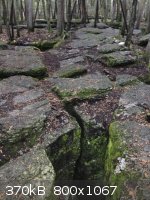 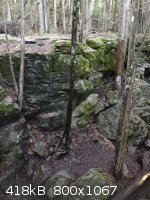
The smooth holes in the limestone here are some small kettles. The kettles are not inherent to the Karst landscape; their creation is due to the fact
that the whole area was a major glacial spillway during the last ice age. There are a few giant kettles in the area (I did not take photos of them),
some of which are large enough for you to climb down into
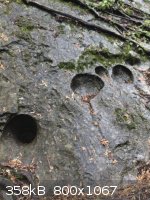
These next two photos are from within the caves themselves, they aren't very big, and show the limestone bedding.
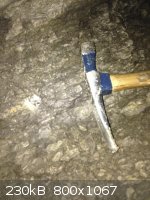 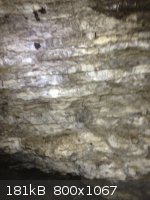
Please excuse the blurry images!
There is a noticeable absence of fossils in the limestone formations (only rarely you see traces of snails/shellfish in the caves) for reasons which I
do not know. Black chert is common in the limestone and you will often see large bands of it cutting through. Also, numerous erratic boulders are
strewn throughout the area due to it being a major glacial spillway. It really is an awesome place!
Bfesser, those dendritic samples you have look sweet!
[Edited on 10-2-2014 by blargish]
BLaRgISH
|
|
|
arkoma
Redneck Overlord
      
Posts: 1761
Registered: 3-2-2014
Location: On a Big Blue Marble hurtling through space
Member Is Offline
Mood: украї́нська
|
|
look like petrified bones. Went on a field trip in school to a phosphate pit in Florida and I remembe
rfinding stuff like that
|
|
|
Morgan
International Hazard
    
Posts: 1694
Registered: 28-12-2010
Member Is Offline
Mood: No Mood
|
|
My cousin used to work at the phosphate mine in Central Florida. He had a huge hand-sized shark tooth from there that was as big as the ones you seen
in museums.
Some fossil news
Researchers discover 'epic' new Burgess Shale site in Canada's Kootenay National Park
http://www.eurekalert.org/pub_releases/2014-02/uot-rd021014....
|
|
|
Morgan
International Hazard
    
Posts: 1694
Registered: 28-12-2010
Member Is Offline
Mood: No Mood
|
|
A few more dendrites and tidbits ...
Numerous nucleation centers
http://minerals.gps.caltech.edu/FILES/DENDRITE/Panamint_Mtns...
http://minerals.gps.caltech.edu/FILES/DENDRITE/best_den.gif
http://minerals.gps.caltech.edu/FILES/DENDRITE/Index.html
|
|
|
Zyklon-A
International Hazard
    
Posts: 1547
Registered: 26-11-2013
Member Is Offline
Mood: Fluorine radical
|
|
I'm not a big rock collector, but I thought I'd post a picture of a cool (in my opinion) rock.
Here is a rock that I found in my creek. 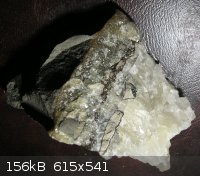
From what I can tell, it's some calcite grown on an unknown rock, with some mica and iron pyrite (iron II sulfide.)
[Edited on 24-2-2014 by Zyklonb]
|
|
|
Morgan
International Hazard
    
Posts: 1694
Registered: 28-12-2010
Member Is Offline
Mood: No Mood
|
|
Kind of an interesting dendrite-like effect.
http://www.youtube.com/watch?v=cmBljeC79Ls#t=2m3s
|
|
|
Morgan
International Hazard
    
Posts: 1694
Registered: 28-12-2010
Member Is Offline
Mood: No Mood
|
|
I found this curious rock out in the garage among some old sea shells and shark's teeth and wondered what it might be. One "top" face that I didn't
photograph just looks glazed like a meteorite but the sides look like bent lines vaguely like petrified wood, or maybe volcanic goings-on. A strong
neodymium magnet will not lift it but it's magnetic and heavy.
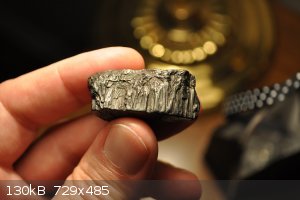 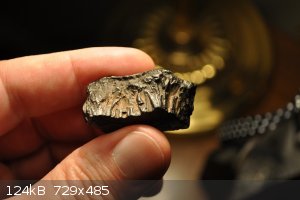 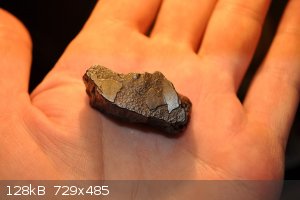
|
|
|
diddi
National Hazard
   
Posts: 723
Registered: 23-9-2014
Location: Victoria, Australia
Member Is Offline
Mood: Fluorescent
|
|
@ morgan
these ones posted on 8-2-2014 at 09:02 are:
1-4 - pertified wood. not sure of species (need to cut it)
5-7 - tiger eye
posted on 4-2-2014 at 05:10
1-2 - selenite "blades" or "flowers"
3-5 - more pertified wood
6-7 - banded orange calcite (massive)
8 - amethyst
posted on 8-2-2014 at 09:02
1-3 - possibly a fine hornblende?
4-6 - purple fluorite
7-8 - bornite
9-10 - lace agate
the lump above I suspect is iron slag?
[Edited on 19-7-2015 by diddi]
Beginning construction of periodic table display
|
|
|
j_sum1
Administrator
       
Posts: 6320
Registered: 4-10-2014
Location: At home
Member Is Offline
Mood: Most of the ducks are in a row
|
|
Now I know who to ask if I need a rock identified.
Nicely done, diddi.
|
|
|
| Pages:
1
2
3
4
5
6
..
8 |